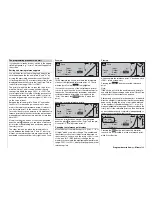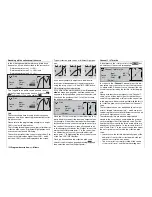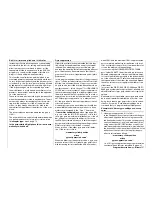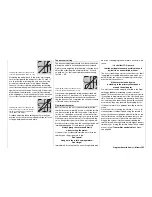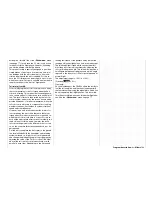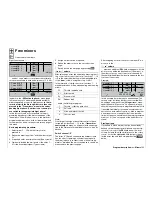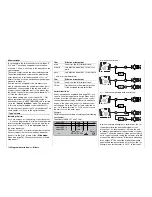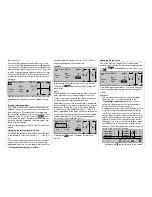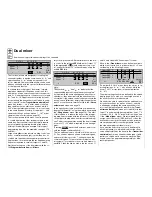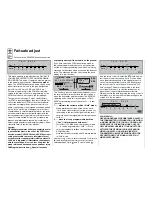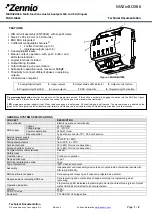
137
Program description:
Mixers
fect of transmitter control signal “6” extends as far
as output “12”, again taking its associated mixer ra-
tio into account. Of course, each individual mixer can
still be controlled via the assigned mixer input cont-
rol even when a serial link has been set up.
Note that
the fi xed-wing and helicopter mixers can also be
set up to act as “serial” mixers in this sense.
Additional special features of free mixers
Mixer input = mixer output
If you set up a mixer whose input is the same as its
output, e. g. 8
8, you can achieve some very spe-
cial effects in conjunction with the option of switching
a free mixer on and off in any way you like.
A typical application for this type of mixer is described
on page 182.
Tip:
If you separate the relevant control function, in this
case “8”, from control channel “8” using the »
MIX
only channel
« menu (see page 142), then the ser-
vo response is defi ned only by the mixer ratio (which
has not yet been programmed). This enables you to
set up linear curves using the mixers 1 … 8, or eight-
point control curves for any transmitter control using
the curve mixers 9 … 12, as described in the »
Chan-
nel 1 curve
« menu, and also include them in the
fl ight phase switching if required. This method of “lin-
king” is also switchable, and can even be assigned a
time delay in the “-time+” column of the »
Transmitter
control adjust
« menu. For more information on this
please see the programming example entitled “Cont-
rolling timed sequences” on page 182.
Mixer output affecting default software coup-
ling of aileron, camber-changing fl ap or collective
pitch servos
• Fixed-wing
models:
Depending on the number of wing servos set in
the »
Model type
« menu, outputs 2 and 5 at the
receiver are reserved for the aileron servos, out-
puts 6 and 7 for the two fl ap servos, and outputs 9
and 10 for the secondary fl ap servos FL2 (if pre-
sent).
If you set up mixers to affect this type of coupled
function, you must take into account the direction
of effect according to the control channel:
Mixer
Effect
N.N.*
2
the servo pair 2 + 5 responds with
an aileron function
N.N.*
5
the servo pair 2 + 5 responds with a
fl ap function
N.N.*
6
the servo pair 6 + 7 responds with a
fl ap function
N.N.*
7
the servo pair 6 + 7 responds with
an aileron function
N.N.*
9
the servo pair 9 + 10 responds with
a fl ap function
N.N.*
10
the servo pair 9 + 10 responds with
an aileron function
• Model
helicopters:
Depending on the helicopter type, collective pitch
control may be provided by a maximum of four
servos connected to receiver outputs 1, 2, 3 and
5, and the
mx
-24s software links them together
to provide the functions collective pitch, roll and
pitch-axis (elevator). It is not advisable to mix one
of the transmitter controls into these already occu-
pied channels using the free mixers available out-
side the »
Helicopter mixers
« menu, as you may
inadvertently generate some extremely complex
and unwanted interactions. One of the few excepti-
ons to this rule is “Collective pitch trim via a sepa-
rate transmitter control”, as shown in Example No.
3 on page 141.
Important notes:
•
It is important to remember when dealing with se-
rial links that the travels of the individual mixers
are cumulative when multiple stick commands are
made simultaneously, and the danger then exists
that the servo concerned may strike one of its me-
chanical end-stops. If necessary reduce the servo
travel to avoid this; alternatively use the “Travel li-
miting” function in the »
Servo adjustment
« menu,
and / or reduce the mixer values.
•
When using a PCM transmission link the cont-
rol data is compressed before being transmitted,
and if you use more than eight servo outputs on
a PCM20 receiver, the servos connected to re-
ceiver outputs 9 and 10 may be slightly less than
smooth-running if the mixers “1
9”, “1
10”
and “2
10” are in use.
If you are using a PCM20 receiver, these effects
may occur at outputs 9 and 10 if you have pro-
grammed mixer combinations in which several
servos are operated in parallel by one transmitter
control. This does not constitute a malfunction of
the radio control system.
• We recommend that you make full use of the
»
Servo display
« menu, which allows you to check
the effects of all your settings on a single screen.
This menu is accessed by holding the rotary con-
trol pressed in and pressing the
HELP
button.
Press the rotary control or the
ESC
button again
to return to your starting point.
* N.N. = Nomen Nominandum (the name to be stated)
Summary of Contents for mx-24s
Page 1: ...1...
Page 19: ...19 For your notes...
Page 35: ...35 For your notes...
Page 41: ...41 41 For your notes...
Page 57: ...57 For your notes...
Page 63: ...63 63 For your notes...
Page 69: ...69 69 For your notes...
Page 85: ...85 85 For your notes...
Page 99: ...99 For your notes...
Page 143: ...143 For your notes...
Page 191: ...191 For your notes...
Page 212: ...212 212 For your notes...
Page 213: ...213 213 For your notes...
Page 214: ...214 For your notes...
Page 216: ...216...

